Body’s Knots
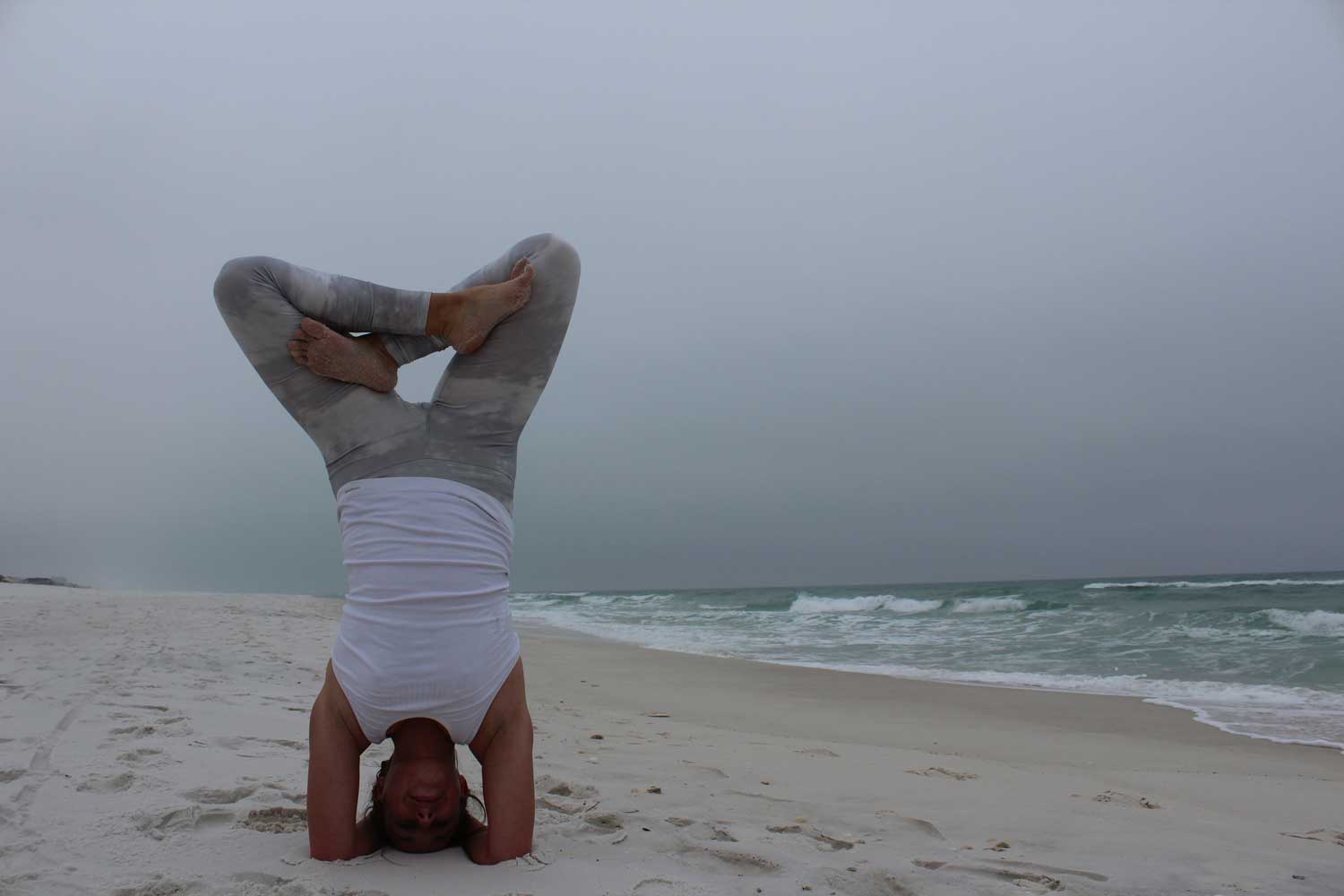
Body’s Knots
Mallory Bass and Lora Straub are poets that live 1,400 miles apart. They grew close in graduate school during an intense productive two years at St. Mary’s College in the Bay Area of California. Since graduation, creativity has ebbed and flowed (as it is wont to do).
Here, Lora interviews Mallory about the relationship between Mallory’s yoga practice and writing’s discipline.
After the interview took place, they worked together on a poem, titled “Body’s Knots” and included below.
Lora And Mallory Talk Creativity, Yoga, & Practice
Lora: Let’s just jump right in. Do you draw any parallels between your creative process and yoga practice?
Mallory: Yes, and I think there are a lot of links between yoga and creativity (poetry in motion? Eh?). Yoga is a way to be lost and be okay with it. It’s maintaining breathing and basically existing through difficulty. It’s not supposed to be comfortable. I’ve spent the last couple of years largely lost from my creative practice, and sometimes I suspect it’s on purpose. Yoga is finding that lost part of me, charting its location and just being with it for a while. I can’t tell yet if it’s bringing it back, but I think it is, slowly.
Lora: Yoga’s difficulty is challenging, strengthening you and preparing you for your next creative endeavor, perhaps?

Forward Fold; Blackwater River, MS. Photo (C) 2015 Alex Webb
Mallory: If anything is, yoga is. When practicing the asanas (postures), each body is given certain capabilities already. For instance, my body is able to do backbends fairly easily. I can open my heart, hang my head, look behind me. But I struggle to do a simple forward fold, to hold myself with self-love and gravity. Forward fold is a place where one can breathe deeper into the back body, feel the breath reach the spine and loop back in and up into the chest. Practicing a standing forward fold for two minutes every day can help with depression (something about bloodflow and gravity). All of this to say, I’m interested in doing more forward folds than backbends, in choosing a path that allows for more growth, more sharpening, more strengthening, and doing less asanas that I’m “good at.” I think that by choosing the more difficult path it’ll prepare me for a creative project, for the creative process.
Lora: Yoga really helps you pay attention to your body and its position in your day to day life.
Mallory: Taking note of the good and taking note of the bad, not freaking out, but just charting your body’s position with awareness is really important, and I think it parallels with writing. Alignment in yoga :: structure in writing, tension and stresses in the body :: conflict in writing. In life we sometimes filter the eventful parts of life (trauma, heartache, pain, love, lust, danger) through writing, and we feel a release, sometimes we even feel triumphant over the event. Yoga is like that in that we willingly place our bodies into difficult positions and we gain grace from those places. We learn how to endure through difficulty, but with an open heart. Posture says so much about a person, and yoga helps your posture a lot. We hunch over and guard our hearts, guard our throat chakras, and we don’t make the choice to do it either–we just go on with our lives with poor posture and very little awareness.
Lora: When we hunch over and guard, we’re not allowing the circulation and openness we need. How important has finding the right studio been since you’ve hopped cities the past year or so?
Mallory: In Austin, [Texas}, finding a studio was reaching an oasis of divine proportions. After spending a year and some change working as an assistant editor for a great lifestyle magazine in Jackson, Mississippi, my hometown, I moved to Austin purposefully without a job, wanting to take a break, which turned into freaking out about not knowing what I wanted to do. Though I ate some great food and saw prime live music, after a couple of months I lost my grip a little bit.
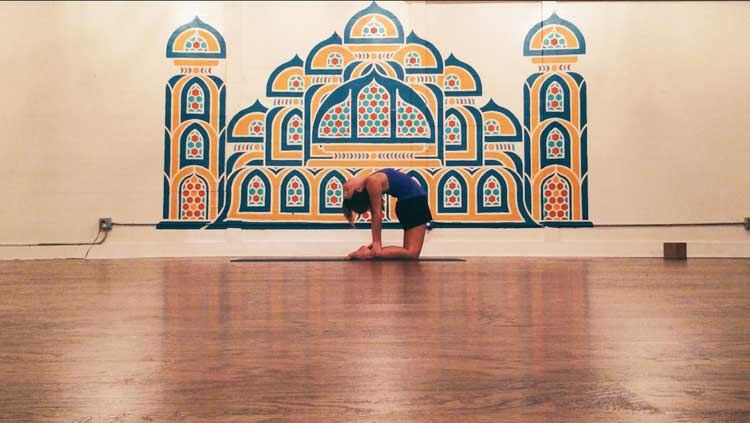
Camel; Practice Yoga Austin, TX. Photo (C) 2015 Mallory Bass
That’s where Practice Yoga Austin comes in. I googled “donation yoga” because I had experienced Yoga to the People in Berkeley, [California], and was attracted to people giving whatever money they could swing. It creates a community centered around equality, love, and gratitude; empowering the spirit, celebrating all levels of practice and all bodies.
I started going to Practice many times a week, and felt that as long as I endured the asanas, stared up at the bare wood ceilings, looked at myself in the wall of mirrors, said “Namaste,” (the light in me recognizes and honors the light in you), and thanked the teachers, I was getting somewhere. Then, I started work-trading for the studio–cleaning it. Taking care of the space became a part of my practice. I was so proud of it, and it helped because I could go to yoga more since I didn’t have to pay money for it. My life started coming together–I began volunteering for a creative nonprofit, remembered I loved books and worked for a bookstore with other book-lovers, and then started teaching. But the rebuilding began with the yoga and that kind community.
We also traveled a lot last year; I practiced in studios in Boston (with you!), Berkeley, El Paso, Santa Fe, Jackson, Natchez, and then we moved to Pensacola. I’ve found that yoga studios are hospitable to travelers, and that styles of yoga differ in each city, like trees, weather, and accents. I’ve only been in Pensacola since December, but the yogis remind me of mermaids; they sing and chant beautifully in class. The Gulf of Mexico has such a fluid influence on all parts of life–sometimes the sound of the ebbing and flowing waves regulates my breathing.
Lora: That’s a wonderful progression. Do you also practice yoga at home?
Mallory: Yes. I’m developing a home practice by picking the asanas that are difficult for me and diving into them each day. I spent a great deal of my life not thinking about my body at all. I had terrible posture and a soft body. It wasn’t until I moved to California for grad school that I considered yoga. Yoga of course means to yoke. It’s the yoking of the mind and body. I find that in times that I need to harness my mind (unemployed in Austin) and tame my ego that I’ve turned to yoga. This past year has been the first time that I’ve practiced regularly. And it’s been intense. We house stresses and traumas and memories in so many areas of the body and yoga really helps us access those places, breathe into them, look around, and let the tension go.
Lora: I’m going to let the “soft body” comment slide my friend.
Mallory: Ha! I was housing beer, and continue to proudly do so.
I’ve been thinking about one of the comments that one of my thesis readers, Shane Book, offered me, and I’m extremely grateful for it and still working it out. He said that I know the ends of my poems too soon, and I hurry up to get there, to that last delicious line. And it’s true. He told me to go into a poem, and get lost in the middle. I think I’m still doing that. I’m still learning to do that. I’m meditating on being lost.
Lora: I think we worry too much about being lost. When we’ve got it all figured out, that’s kinda boring. Then we’ve reached the end.
Mallory: I go into a poem and then I’m like, “Wait, what’s the point of writing this if I can’t solve the poem? What is the solution?” Then something pops in my head and without judgment I assume it’s the solution! Boom! Ending line.
Lora: So it is too fast, you don’t let yourself get scared.
Mallory: Right! So now maybe the writing self in me is saying, “Oh, I’m just finally in the middle of a poem, no big deal.”
Lora: I think the scariest poems are those scraps we find that we can’t let go of…those three-liners that you feel so unsure of that you put them aside when they should be meditated over. Not knowing why something is significant to myself, but that it is, is scary. I really need to do some yoga!
Mallory: I think the clue is that it is significant, and just being aware that you have no control over why it’s significant.
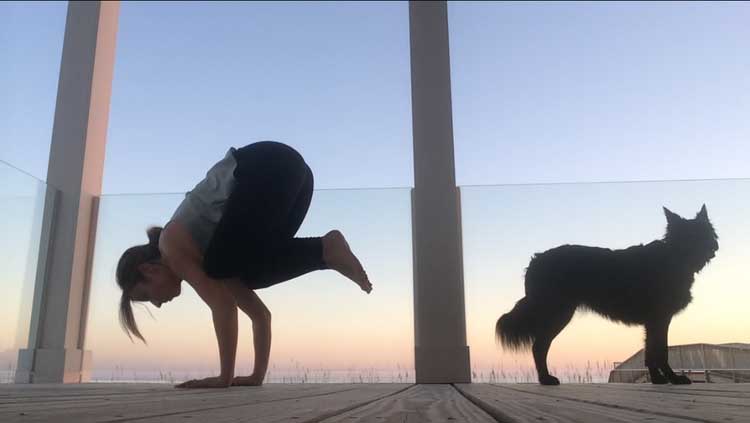
Crow; Pensacola, FL. Photo (C) 2015 Alex Webb
Sometimes I think fear is what keeps us from being present. Remember when you were a kid? And you have all these really vivid memories, right? Of just moments. And it’s because you’re not thinking about everything else. You’re completely there in that moment. I think that’s what love is. Not romantic love but the love that is just there. The love that’s the same thing as living. So maybe fear is the opposite of love? In yoga fear is what keeps you from doing some poses. Most poses that are challenging just take a moment for you to trick yourself into doing them. In Crow Pose, you’re scared your arms are going to give out and you’re going to fall on your head, but your head is only a few inches from the floor and it’s really your core and legs hugging into your midline that’s keeping you from not falling. But you’re still irrationally scared.
Lora: I’ve read often that indifference is the opposite of love. I think fear allows us to be indifferent or that it actually makes us indifferent to love.
Mallory: Breathing also. If you’re in a difficult pose, you start breathing irregularly, or worse, you hold your breath. But if you keep your breathing steady, you’re sending signals to your body that you’re not in danger, that you’re choosing to be in that pose. One of my teachers said that if you can change your breathing you can change your thoughts. And that’s powerful. It’s amazing how air calms you down. It’s all you need. As long as you’re breathing everything is fine. It’s pretty much the only thing we have to do.
Lora: Yes, I wrote something like that in my journal last night, but I went negative: “When I’m not writing the thoughts still go, I’m still breathing involuntarily, but that doesn’t make it easy.”
Mallory: Ugghhhh I love that. My mantra this past year has been, “Well when the words don’t come, I can just make shapes with my body.” I wouldn’t be as attracted to yoga if I didn’t have to think about the language of it. “Lift your kneecaps, point your tailbone to the ground, breathe into your backbody…” You have to think so specifically, and those thoughts trigger forming the actual pose, connecting the mind to the body.
Lora: The descriptions of what you’re doing are almost surreal! We don’t usually think about those parts of our bodies.
Mallory: It goes back to awareness. When you have to think about activating specific parts of your body, you have to locate the parts you wouldn’t ordinarily think about, and breathe into them. It’s just showing love.
Lora: We all need more self love. Well, some people don’t, haha.
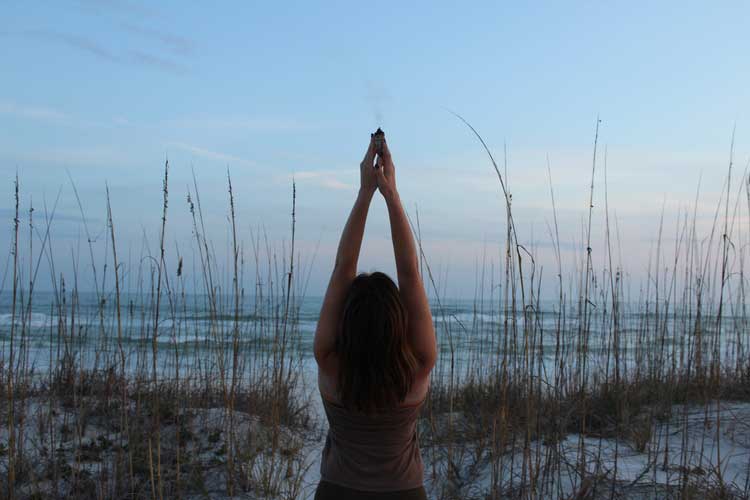
Mountain with Sage; Pensacola, FL. Photo (C) 2015 Alex Webb
Mallory: Right now, I’m reading Light on Yoga by B.K.S. Iyengar and it runs through each pose–where it came from, the sanskrit name, and then the translation, how to get into the pose, how long to stay, the benefits. For instance, Mountain Pose–the first pose in a sun salutation, where it may look like you’re just simply standing there, isn’t so simple. You push down into all four corners of your feet, lift your knee caps, tuck your tailbone, engage your core, raise your shoulders and then push them down your back away from your ears, shoot your arms down at your sides and open your palms, grow your fingers to the floor. It’s called “Tadasana” in sanskrit. “Tada” means “mountain,” and “asana” is sanskrit for “pose.” If you just stand, somebody can pick you up maybe even if it’s just an inch off the ground, but if you stand in Tadasana, somebody can walk up to you, try to lift you, and they won’t be able to. You’re somehow heavier because you’re pushing your weight down.
Lora: That’s super cool! When you engage, everything becomes more complex. Yet when you break the language down it isn’t as tricky…I hear asana type words all the time at yoga. Now I know what that part means.
Mallory: Yep! Most of the poses relate to stories in scripture, the Bhagavad Gita, the major authority on yoga philosophy. For instance, the Lord of the Dance pose (Natarajasana) depicts the Hindu god Shiva as he dances to destroy the universe and make way for creation.
Lora: It runs so deep. No wonder people make it their whole lives.
Mallory: They really do. So many American teachers travel to India to study with descendants of the first yoga teachers.
(She recommends a really great documentary on Netflix called Breath of the Gods.)
Lora: I was thinking the other day about this nightly ritual with my niece. Before you put her in her sleeper, you rub a thin layer of lotion on her delicate baby skin. It’s a quick but thoughtful process, and she loves it. Our bodies need something like that, too, but we don’t need parents anymore, we have to do it ourselves. It’s harder. Yoga makes me feel good like that. Like I’m the parent and the baby. That’s why I loved the restorative yoga class I took. I just felt like this baby taking care of myself.
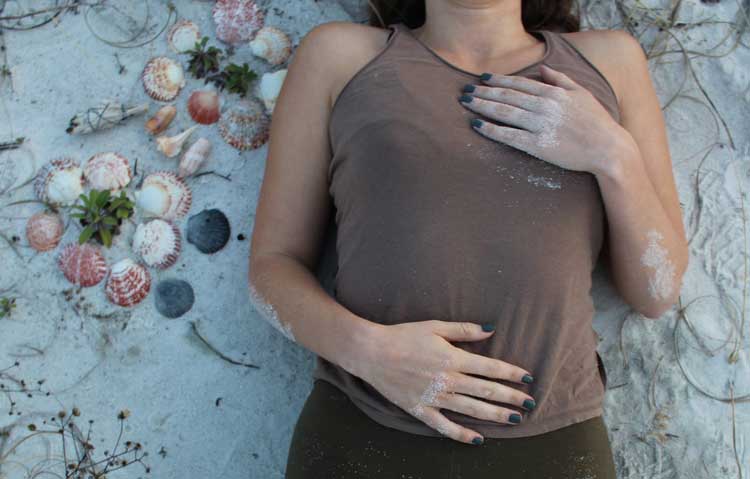
Savasana; Pensacola, FL. Photo (C) 2015 Alex Webb
Mallory: I think about that a lot, and I want to say it has a lot to do with being in our mid-twenties, but it continues on. We have the equipment to take care of ourselves but so often we don’t do it. It’s hard. Yoga allows us to experience the difficulty of life through the metaphor of our body. We are spirits within our bodies, within our minds, our bodies are like our armor, our spaceship through which we travel, and we need to feel good inside of it. It’s cathartic in the way of watching a tragic play–we experience the tragedy within a vessel, and we get through it. Savasana, where we lie down on the floor at the end of class, is Corpse Pose. We practice for death. And then we roll over into the Fetal Pose, reborn.
Lora: Going to yoga you’re going to a story too, or to participate in a play.
Mallory: As writers, it’s said that we experience life twice (Anais Nin, maybe?). Yoga is kind of like that.
Lora: Yeah! Two forms of life. We’re driven to record. Yoga’s a form of recording it, too.
Mallory: Yes! You’re letting your body tell the story, and it’s an ancient story. These poses are archetypes.
Lora: And the instructor decides on the order of the class. What a ritual. We writers, so driven to the meta.
Mallory: Yes, and here’s the deal with instructors. Most often, they’re these chosen beings. Your instructor had a teacher, who had a teacher, who had a teacher, and each passed on this nugget of truth and wisdom to one another and then that’s what we get to experience in class. Torch-passing.

Bound Wheel; Pensacola, FL. Photo (C) 2015 Alex Webb
Lora: I’ve actually never had a bad yoga teacher. There have been some teachers I’ve liked more than others, but I couldn’t say any were bad.
Mallory: Right? One of my first yoga teachers in Austin, Missy Shaw, led this Sunday practice in an open field by Lake Austin. She’s an intensely spiritual teacher, has crystals to make an altar, focuses on the stresses we harbor in our hips and hamstrings, and after practice we all jumped into the lake. It was cleansing. Like poets, yogis make me believe in humanity. They focus on a certain need, and tell the truth about it. The community is a great factor too, at my first class in Pensacola, a fellow yogi gave me a scoby to start brewing Kombucha. It’s a lifestyle that transcends just stretching your body parts.
Lora: Bright colors, bright spots.
Mallory: At our best, we gravitate toward light. Sometimes it’s easier to give into gravity, and that’s okay, the dark is part of all of it, too. I want to understand the dark better so that I have empathy for other people and love them better. I just don’t want to stay there.
Lora: Some people are so hard to love.
Mallory: Truth, my first thought is that maybe that goes back to self-love.
Lora: I think people that self-love let go better. Not more easily, but of toxic things.
Mallory: Exactly! They know that they deserve better, or just what they don’t deserve. When you earn your own love, you know how to love others, at least generally. Yoga is definitely the act of self-love, and if it starts out stressful or unloving, it at least takes you closer.
Body’s Knots
A poem by Mallory Bass and Lora Straub
We ouija inward to find the lost letters,
piece them into words of deep work. Twist
the body, pull the breath into islands;
worth grows less shallow past the sand-
lit shores, the middle of a pose, and rough
stones sink beyond pulley’s reach.
Distracted, the mind follows to the floor,
grooved stillness, no sound but echo,
distance filters down the light in lines
waving gently. The sand is your new sky,
another abstract fact you long to touch, to place
your thoughts inside the center of your bones.
From the marrow home we move, tend-
ons to muscles, a gull skirts the water’s white
seam toward light (flight first insists direction).
Horizon-bound our hands tend towards
shaking, as the target holds, switching the course
of blood in the slightest shifts. Reaching,
we breathe into our fingertips, to the tactile
points where the body ends and greets a melting
stranger, that one skipping comma-shaped
shells across the water we’ve been meaning to love.
Be the first to comment